#Roosevelt Warehouse
Explore tagged Tumblr posts
Video
His Advanced Degree by Thomas Hawk
#Corktown#DPS Book Depository#Detroit#Detroit Book Depository#Michigan#Roosevelt Warehouse#Wayne County#abandoned#book depository#flickr
0 notes
Text
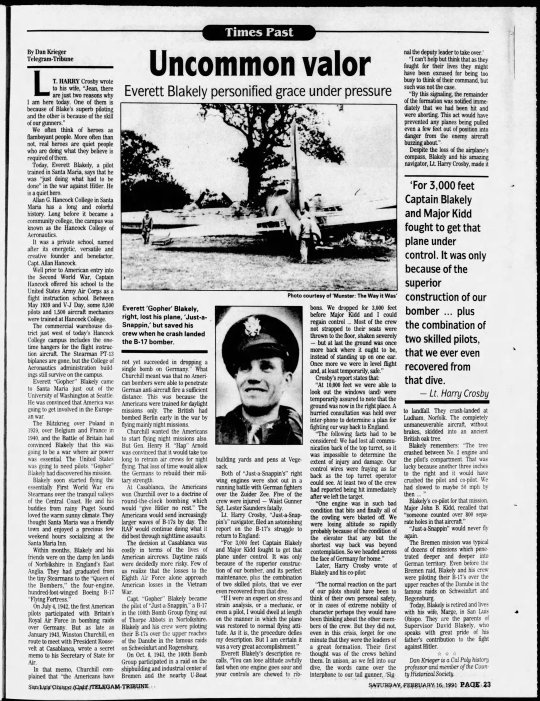
A really great article about what the crew of the Just-a-Snappin' went through on the Bremen raid on October 8, 1943.
Transcript below Read More
Article found through this page on the 100th Bomb Group site
Article named: Uncommon valor
Subheading: Everett Blakely personified grace under pressure
By Dan Krieger Telegram-Tribune
Photos of the Just-a-Snappin' crashed into a tree, and one of Blakely smiling in uniform. The latter with the message "Everett 'Gopher' Blakely, right, lost his plne, 'Just-a-Snappin.' but saved his crew when he crash landed the B-17 bomber.
Pull quote in the article: 'For 3,000 feet Captain Blakely and Major Kidd fought to get that plane under control. It was only because of the superior construction of our bomber... plus the combination of two skilled pilots, that we ever even recovered from that dive. -Lt. Harry Crosby
Main article: Lt. Harry Crosby wrote to his wife, "Jean there are just two reasons why I am here today. One of them is because of Blake's superb piloting and the other is because of the skill of our gunners."
We often think of heroes as flamboyant people. More often than not, real heroes are quiet people who are doing what they believe is required of them.
Today Everett Blakely, a pilot trained in Santa Maria, says that he was "just doing what had to be done" in the war against Hitler. He was a quiet hero.
Allan G. Hancock College in Santa Maria has a long and colorful history. Long before it became a community college, the campus was known as the Hancock College of Aeronautics.
It was a private school, named after its energetic, versatile and creative founder and benefactor, Capt. Allan Hancock.
Well prior to American entry into the Second World War, Captain Hancock offered his school to the United States Army Air Corps as a flight instruction school. Between May 1939 and V-J Day, some 8,500 pilots and 1,500 aircraft mechanics were trained at Hancock College.
The commercial warehouse district just west of today's Hancock College campus includes the one-time hangers for the flight instruction aircraft. The Stearman PT-13 biplanes are gone, but the College of Aeronautics administration buildings still survive on campus.
Everett "Gopher" Blakely came to Santa Maria just out of the University of Washington at Seattle. He was convinced that America was going to get involved in the European war.
The Blitzkrieg over Poland in 1939, over Belgium and France in 1940, and the Battle of Britain had convinced Blakely that this was going to be a war where air power was essential. The United States was going to need pilots. "Gopher" Blakely had discovered his mission.
Blakely soon started flying the essentially First World War era Stearmans over the tranquil valleys of the Central Coast. He and his buddies from rainy Puget Sound loved the warm sunny climate. They thought Santa Maria was a friendly town and enjoyed a precious few weekend hours socializing at the Santa Maria Inn.
Within months, Blakely and his friends were on the damp fen lands of Norfolkshire in England's East Anglia. They had graduated from the tiny Stearmans to the "Queen of the Bombers," the four-engine, hundred-foot-winged Boeing B-17 "Flying Fortress."
On July 4, 1943, the first American pilots participated with Britain's Royal Air Force in bombing raids over Germany. But as late as January 1943, Winston Churchill, en route to meet with President Roosevelt at Casablanca, wrote a secret memo to his Secretary of State for Air.
In that memo, Churchill complained that "the Americans have not yet succeeded in dropping a single bomb on Germany." What Churchill meant was that no American bombers were able to penetrate German anti-aircraft fire a sufficient distance. This was because the Americans were trained for daylight missions only. The British had bomber Berlin early in the war by flying mainly night missions,
Churchill wanted the Americans to start flying night missions also. But Gen. Henry H. "Hap" Arnold was convinced that it would take too long to retrain air crews for night flying. That loss of time would allow the Germans to rebuild their military strength.
At Casablanca, the Americans won Churchill over to a doctrine of round-the-clock bombing which would "give Hitler no rest." The Americans would send increasingly larger waves of B-17s by day. The RAF would continue doing what it did best through nighttime assaults.
The decision at Casablanca was costly in terms of the lives of American aircrews. Daytime raids were decidedly more risky. Few of us realize that the losses to the Eight Air Force alone approach American losses in the Vietnam War.
Capt. "Gopher" Blakely became the pilot of "Just-a-Snappin," a B-17 in the 100th Bomb Group flying out of Thorpe Abbots in Norfolkshire. Blakelly and his crew were piloting their B-17s over the upper reaches of the Danube in the famous raids on Schweinfurt and Rogensburg.
On Oct. 8, 1943, the 10th Bomb Group participated in a raid on the shipbuilding and industrial center of Bremen and the nearby U-Boat building yards and pens at Vegesack.
Both of "Just-a-Snappin's" right wing engines were shot out in a running battle with German fighters over the Zuider Zee. Five of the crew were injured - Waist Giner Sgt. Lester Saunders fatally.
Lt. Harry Crosby, "Just-a-Snappin's" navigator, filed an astonishing report on the B-17's struggle to return to England:
"For 3,000 feet Captain Blakely and Major Kidd fought to get that plane under control. It was only because of the superior construction of our bomber, and its perfect maintenance, plus the combination of two skilled pilots, that we even recovered from that dive.
"If I were an expert on stress and strain analysis, or a mechanic, or even a pilot, I would dwell at length on the manner in which the plane was restored to normal flying attitude. As it is, the procedure defies my description. But I am certain it was a very great accomplishment."
Everett Blakely's description recalls, "You can lose altitude awfully fast when one engine goes sour and your controls are chewed to ribbons. We dropped for 3,000 feet before Major Kidd and I could regain control... Most of the crew were not strapped to their seats were thrown to the floor, shaken severely - but at last the ground was once more back where it ought to be, instead of standing up on one ear. Once more we were in level flight and, at least temporarily, safe."
Crosby's report states that:
"At 10,000 feet we were able to look out the windows (and) were temporarily assured to not that the ground was now in the right place. A hurried consultation was held over inter-phone to determine a plan for fighting our way back to England.
"The following facts had to be considered: We had lost all communication back of the top turret, so it was impossible to determine the extent of injury and damage. Our control wires were fraying as far back as the top turret operator could see. At least two of the crew had reported being hit immediately after we left the target.
"One engine was in such bad condition that bits and finally all of the cowling were blasted off. We were losing altitude so rapidly probably because of the condition of the elevator that any but the shortest way back was beyond contemplation. So we headed across the face of Germany for home."
Later, Harry Crosby wrote of Blakely and his co-pilot:
"The normal reaction on the part of our pilots should have been to think of their own personal safety, or in cases of extreme nobility of character perhaps they would have been thinking about the other members of the crew. But they did not, even in this crisis, forget for one minute they were the leaders of a great formation. Their first thought was of the crews behind them. In unison, as we fell into our dive, the words came over the interphone to our tail gunner, 'Signal the deputy leader to take over.'
"I can't help but to think as they fought for their lives they might have been excused for being too busy to think of their command, but such was not the case.
"By this signaling, the remainder of the formation was notified immediately that we had been hit and were aborting. This act would have prevented any planes being pulled even a few feet out of position into danger from the enemy aircraft buzzing about."
Despite the loss of the airplane's compass, Blakely and his amazing navigator, Lt. Harry Crosby, made it to landfall. They crash-landed at Ludham, Norfolk. The completely unmaneuverable aircraft, without any brakes, skidded into an ancient British oak tree.
Blakely remembers: "The tree crashed between Np. 2 engine and the pilot's compartment. That was lucky because another three inches to the right and it would have crushed the pilot and co-pilot. We had slowed to maybe 50 mph by then..."
Blakely's co-pilot for that mission, Major John B. Kidd, recalled that "someone counted over 800 separate holes in that aircraft."
"Just-a-Snappin" would never fly again.
The Bremen mission was typical of dozens of missions which penetrated deeper and deeper into German territory. Even before the Bremen raid, Blakely and his crew were piloting their B-17's over teh upper reaches of the Danube in the famous raids on Schweinfurt and Regensburg.
Today, Blakely is retired and lives with his wife, Marge, in San Luis Obispo. They are the parents of Supervisor David Blakely, who speaks with great pride of his father's contribution to the fight against Hitler.
-three stars end the article and separate a note about the author
Dan Krieger is a Cal Poly history professor and member of the County Historical Society.
-Along the bottom of the page the article is attributed to the San Luis Obispo (Calif.) Telegram-Tribune in the Saturday, February 16, 1991 edition on page 23.
#masters of the air#mota#real guys#everett blakely#just-a-snappin'#goblin fort appreciation society#jack kidd#harry crosby#dana rambles#Bremen mission#October 8 1943
56 notes
·
View notes
Text
2️⃣
‘Comprador’ refers to an agent of a large multinational corporation whose typical job responsibility is taking a small underdeveloped nation and turning it into a vending machine for a natural resource - oil, coffee, coal, minerals - then getting that nation so dependent on selling those raw materials to that company that they effectively control it.
Unrelatedly, the Global Logistics Network was the single largest anything of 2069.
They weren’t a monopoly, no, no, no. They were… you see, the crowded and fragile system of intercontinental shipping was simply too important to be left in the hands of any single nation. You all saw what happened when the Brits monopolized it, and when the US monopolized it after them. You’ve seen how nations owning major canals turns them into a hive of corruption. Shipping belongs to the world, which means it belongs to the GLN.
They were headquartered in Qingdao, a major city in the Shandong province of China. Don’t be fooled, China fumbled the past few decades as much as everyone else, but every institution needs a head, and every head needs a headquarters, and the headquarters of the Global Logistics Network were located in Qingdao. The complex of skyscrapers that comprised GLNHQ was large and populous enough to form its own city-state, a closed loop of offices, gyms, fabricators, dormitories, labs, shops, copackers, cafeterias, and warehouses. You could spend your whole life there without ever setting foot on the earth itself. Many did.
Such was the Global Logistics Network. Like capitalism rising centuries ago from the sclerotic and shambling remnants of feudalism, the GLN rose from the old ways of hyper-financialized over-leveraged capitalism to create something new, something so new it didn’t even have a name yet. Much like the transition from feudalism to capitalism, things were better overall, but good lord, what a low bar to clear.
Towering above it all at the top floor of the central skyscraper sat Meng “Harold” Jianli, sole co-founder of the GLN. One might wonder how someone could be a ‘sole co-founder,’ and the answer was that the GLN was so powerful and omnipresent that its leader could have called himself a living god for all the power that sat upon his person. He certainly had more power than those who had historically claimed the title of living god.
But Meng “Harold” Jianli was no god, living or otherwise. Despite the vast power seated upon his person, or perhaps because of it,he looked rather disheveled, with a jowly face like splotchy old parchment, a sagging belly, and a crudely functional flat-top of black hair. His suit was slack and rumpled - his weight had a tendency to fluctuate wildly thanks to the stress.
It was stressful, being in charge. Past a certain point, you don’t really get more powerful, you just have more people to babysit and more fires to put out. He had to keep an eye on Novo Karo Bioresearch, or they’d be so excited to show off their new research that they’d start doing eugenics. He had to keep an eye on Vae Victis Engineering, or they’d get so excited testing out their new tech that they’d start a world war. And now, with his hands steepled and his brow furrowed, he had to keep an eye on the vtuber that the American League had elected president.
He stared at Sunny Roosevelt. Sunny smiled back and gave him a little wave.
“I am willing to work with you, miss Roosevelt. The GLN is willing to work with just about anyone, it’s one of our biggest strengths.” He shifted effortlessly between ‘I’ and ‘we,’ treating the two as synonyms. “The issue is, we are still trying to figure out what your administration actually intends to do.”
“Hmm.” Sunny put a finger to her chin, pursed her lips, and looked upward. An ellipsis appeared over her head. “You got a copy of my campaign objectives, right?”
“Are you referring to this?” He held up a single sheet of paper, on which was written ‘make anime real’ in 48-point font and nothing else.
“Yep!”
“And you think this qualifies as a roadmap for your presidency.”
“Personally, I think it’s quite ambitious.”
Harold puttered his lips. “Miss Roosevelt-”
“Please, call me ‘mommy.’”
“Miss Roosevelt, I understand that you are standing on rather shaky ground. The National Board of Directors is being dragged away from the provisional US government days,” he said, which neglected to mention how half of the National Board of Directors were former GLN big names, “and the new state congress acts more like a rehab clinic for celebrity podcasters than a governing body,” he said, which stood just fine without caveats.
“I understand,” Sunny said, nodding and still smiling, “I’m a bimbo who’s in way over her head, so you’re going to unveil the GLN’s big five year plan and tell me to follow it like a good little girl.”
Harold was already in the process of lifting a hefty unlabeled binder, intending to thump it dramatically atop his desk, but the accuracy of Sunny’s comment left him slightly deflated. “I prefer to think of it as an advisory-”
“And then I’ll kiss up to you during our conversations,” Sunny continued, “but stall and drag my feet when it comes to actually implementing anything, and you’ll say,” she loosened her face and dropped her voice, “dammit Sunny, are you trying to play me for a fool?”
“I don’t sound like that. I don’t sound like Richard Nixon,” Harold protested, sounding kind of like Richard Nixon.
“And then I’ll say, it’s not me, it’s the state governors, they just refuse to cooperate. The new congress is one big old boy’s club. Even the Board of Directors is demanding overly-detailed descriptions of everything before they’ll sign off on it, it’s malicious compliance!” Sunny hung her head and threw her hands, wailing, “you set me up to fail, Harold. You set me up to fail, you rat bastard!”
“Are you done?”
Sunny straightened back up. There was that smile again. “Yep. That was fun.”
“In any case, while I understand you are currently something of a figurehead, even figureheads cannot afford to do nothing. Not when a third of the country is still lacking even the barest measures of centralized government.”
“What, you mean the Midwest Autonomous Zone?” A little question mark appeared over Sunny's head. “I mean, yeah, but it’s not like that started with the fall of the old US. Missouri was a dump long before the thirties.”
“Be that as it may-”
“That’s the 2030s, because we’re in the future.”
“Miss Roosevelt.”
“Please, call m-”
“No. Miss Roosevelt, why did you become president if you are so averse to actually presiding?”
Sunny shrugged and let out a huffy little sigh. “Look, most people weren’t exactly begging to have America back. Not even Americans. They don’t want someone with a bold, inspirational vision. Bold, inspirational visions are what start world wars, for George’s sake. I, for one, believe that bench-warming is not just a good idea but a moral imperative.”
“George’s sake?” Harold repeated.
“Saint George Washington. Oh, right, America’s got a brand new religion now, it’s called Founderism. We took the whole Founding Father worship thing and made it an official heresy. Also, Jesus was a small business owner.”
Harold grimaced and considered leaving the former USA to the wolves for a few more decades.
40 notes
·
View notes
Photo
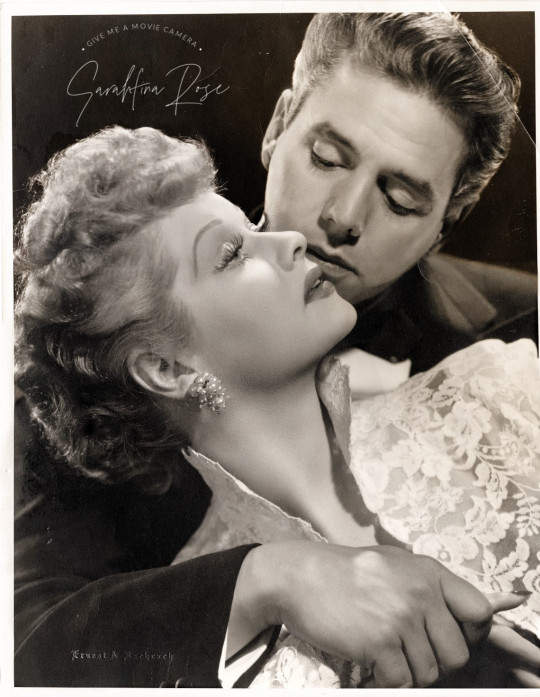
I was watching I Love Lucy on Pluto TV last night and it completely slipped my mind that yesterday marked Desi Arnaz’s 106th birthday.
His was a classic Riches-to-Rags, Rags-to-Riches Cinderella tale. Desiderio Alberto ‘Desi’ Arnaz y de Acha III was born 2 March 1917 in Santiago de Cuba, Oriente Province, Cuba, the only son of wealthy landowner Desiderio Alberto Arnaz y de Alberni II (a prominent Cuban politician, who, to date, was the youngest mayor of Santiago de Cuba from 1923 to 1932) and his wife, Dolores ‘Lolita’ de Acha y de Socías (one of the most beautiful women in the Caribbean, the daughter of a businessman, one of three founders of Bacardi Rum Limited, the world's largest privately-owned spirits company). Desi was of the small but vastly privileged, upper-class y de Acha, the descendent of Cuban nobility of whose colonial ancestors originated from Santander, Provincia de Cantabria, Cantabria, Spain. (His grandfather, Dr Desiderio Alberto Arnaz y Alberni I, was assigned to the first United States volunteer cavalry in Cuba, the ‘Rough Riders’ under the leadership of ‘Hero of Cuba’ Theodore Roosevelt during the Spanish-American War on 1 July 1898. To legend, they sieged San Juan Hill on horseback, and though the forged conquest did not belong primarily to Roosevelt, for the conflict was an integrated effort between the white volunteer regiment and the 1,250 black Buffalo Soldiers, the famed battle gained Cuba her independence from Spain—a victory for the people, the Cuban people).
At the height of the Cuban Revolution of 1933, Desi and his family were forced to flee their Motherland, leaving their riches behind. Following a brief election, the government collapsed with the removal of President Gerardo Machado y Morales from office in August of 1933. The opposing anarchists seized all political leaders and stripped them of their power. Among them, Desi’s father, imprisoned by the regime, before his brother-in-law, Alberto de Acha, intervened on his behalf, thus making his escape to Miami, where he was to remain in exile. Having lost their holdings to the rebels who confiscated their property (their palatial home, a cattle ranch, two dairy farms, and a vacation villa on a private island in Santiago Bay), his father sent for Desi and his mother, who took refuge in Key West, Monroe, Florida in 1934. When Desi washed upon the shores of the Americas, his father had established an import-export company, where the family of three took up frugal lodgings in the company warehouse and dined on cans of cold beans. Desi came to live in New York City and Los Angeles for about one year, where he tightened his belt for survival and scrambled for employment as a struggling musician. Following an engagement as a guitar player for a Latin-American band at the Roney Plaza Hotel in Miami Beach, and a cursory stint with the Xavier Cugat Orchestra in 1937, he made his Broadway debut in the Rodgers and Hart musical Too Many Girls, where he reprised the role for RKO's major motion picture of the same name in 1940. During the course of filming, he fell head-over-heels for the Apricot Queen, Lucille Désirée Ball. The couple eloped on 30 November 1940 in Greenwich, Fairfield, Connecticut. By 1949, at the age of thirty-two, Desi established himself a renowned nightclub entertainer as conga-playing band leader for the travelling self-titled Cuban orchestra.
Most Hollywood buffs would do well to remember the Power Couple formed by Desilu Productions—a celluloid empire built on the backs of Lucy and Desi’s American Dreams, despite the public scandals and tumultuous marital woes. But at the crowning glory of their golden existence, there are those who neglect Desi's legacy and his reluctant resignation to his fate as the Man Behind the Curtain, to remain in Lucy’s shadow so long as he lived. Lucy, of whose celebrity distinction was of higher standing than her husband’s. Desi, though undoubtedly talented, who was not exempt from the unjust ostracization and societal prejudice that plagued him as a Cuban Spaniard immigrant in racially-charged Hollywood. For those who clutched their pearls at the prospect of Middle American households who might've dismissed acceptance of the world’s first interracial couple on television, Lucy and Desi defied those expectations and dissolved racial barriers in an era dominated by cultural strife. Audiences of all races, colour, and creed came together to shower the Ricardos with adoration and praise, because they came to understand the Ricardos epitomized the human experience, no matter that they didn't reflect the typical post-war domestic demographic. Against all odds, the world fell in love with the All-American Ricardos… white, Hispanic, or otherwise. Lucy and Desi, to be envied by all... America's Sweethearts.
On his 106th birthday, we remember Desi for the pioneer he was, as the Mastermind behind the nation’s most Beloved Redhead.
Behind every great woman lies a greater man.
Perhaps Desi speaks for us all when he declared his everlasting love, in his own words... ‘I Love Lucy was never just a title.’
💓 Happy Heavenly Birthday, Desi. 💓
𓆩♡𓆪 · ・ 𓆩♡𓆪 · ・ 𓆩♡𓆪 · ・𓆩♡𓆪 · ・ 𓆩♡𓆪 · ・
#my edit#classic television#old hollywood#1950s#I Love Lucy#p: desi arnaz#p: lucille ball#happy heavenly birthday
40 notes
·
View notes
Text
Are you guys ready for another massive life update post??

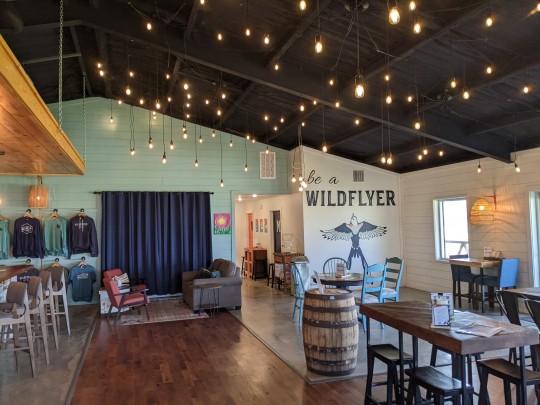
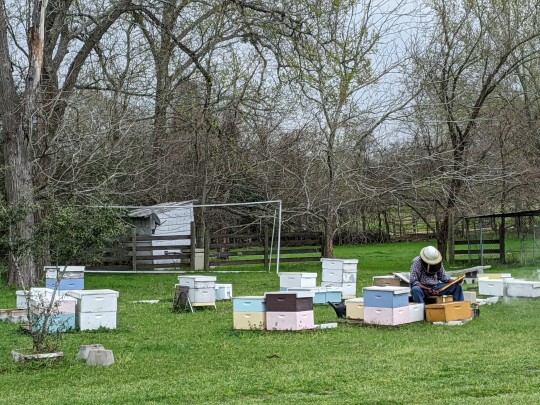





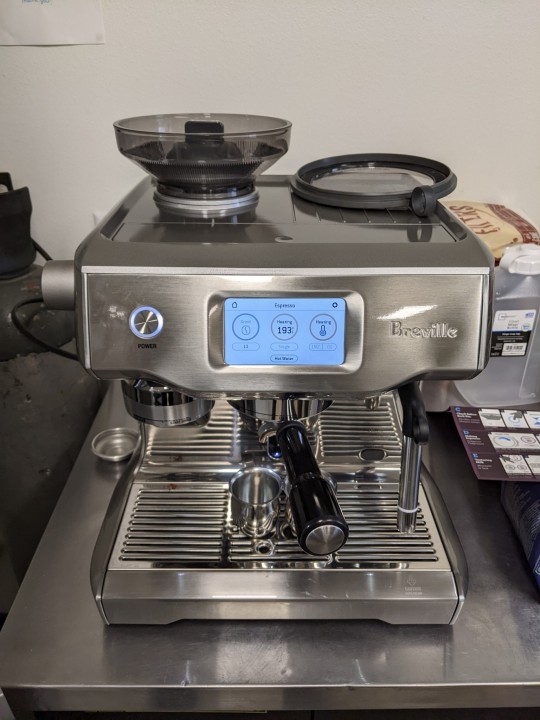
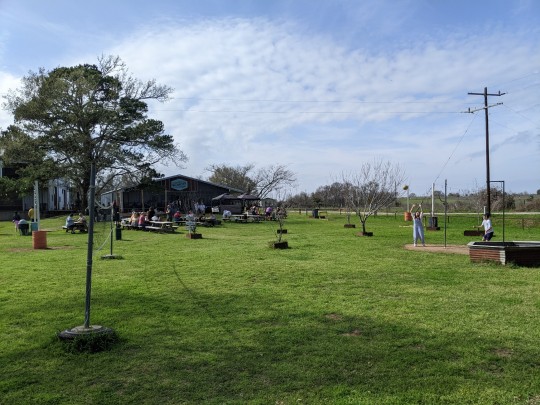
Oy vey, where to begin lol. I think it's only been a week since I've last checked in, but I'm exhausted. In a good way, though, honestly. I've really fallen in love with the bee farm. I'm busier THAN a bee right now lol, but it's not just tedious tasks or some stressful two-step negotiation dance that gets me nowhere, thankfully. I'm just learning, helping, building, and changing my environment where I can. And it's been very fulfilling.
Pictures 1, 3, and 4 illustrate the work I've been putting towards the farm's kitchen. The kitchen was someone's brain child, but unfortunately, no one already had the knowledge, skills, or experience to launch it in a professional way, until they found me. So it has been running haphazardly since 2021. This isn't a slam post, they've been doing their best and honestly, they've been doing great for what all they have. But for someone like me who can walk into an under-functioning kitchen and immediately fix 20 things without a hard thought about it, there's so much improvement to be made. We're working on structuring the environment in a professional, safe, and healthy way, as well as developing new, sustainable, delicious recipes, formulating a permanent and comprehensive menu, as well as providing structured and consistent training to all employees who may have to step into that kitchen. I have the know how, and they have the willpower and the workforce, so we're bringing the kitchen into it's modern form for success and stability. Currently, the farm has contracts with multiple food truck owners, who come out on weekends to provide a fresh food option to patrons enjoying the campus or staying overnight. We hope to move towards being completely self-sustaining and able to provide a full day's worth of meals straight from our own means, which all highlight our most precious resource, our honey. It's been a monumental task, especially since I'm still working full time retail in the shop and bee keeping warehouse, but it's been an exciting project that is rapidly improving every day. We've bought an espresso machine as well as a commercial drip brewer, and soon I'll be training everyone on coffee and craft drinks! Can't wait. I've already made everyone's day by making them their own hand crafted, honey based lattes, and they all seem very excited to start learning.
Picture 2 is our most esteemed bee keepers, Roosevelt, working in the Learning Yard. He's been with the farm for 57 years!!!!!! He's incredibly knowledgeable, talented, and kind. I hope to do more work with him when I begin my hands-on bee keeping education. For now, I'm learning the history and functionality of the farm so that I can give history tours to customers, as well as cementing my basic bee keeping and bee tool/resource knowledge for retail, so that I can most efficiently help our customers find exactly what they are looking for according to their wants and needs, such as a whole beginner's bee keeping set up with brood boxes and bee packages, or answering more advanced bee keeping questions and offering insightful options to unique situations. I also know a butt-ton about the properties, uses, and unique flavor profiles of all our different honeys, and really enjoy giving honey tastings and recommendations in our shop. I already know quite a bit about the many kitchen uses for honey, thanks to my culinary curiosity, and I'm enjoying learning all the uses and applications of other bee related products.
Pictures 5, 7, and 10 are just some slice of life shots: a pop of spring with early wisteria on the farm, the owner's sweet puppy, Chewy, and some customers enjoying the lawn in the afternoon warmth. The weather has been up and down like crazy lately, but we're expecting to get very busy soon as the temperature evens out and rises.
Picture 6 shows me and Kate out and about in town, running errands and being 'go fers' for the needs of the crew. We're about 30 minutes outside of the main area of the local town, so it's kind of a haul to go shopping, but someone's gotta do it. Picture 8 is another queen cage, with one of our first bred queens of the season! You can see her because she has a tiny little sticker on her back for identification and inspection purposes. Picture 9 is inside of our meadery, Wildflyer. I tried some of our mead for the first time last night, just a sip. It was delicious 😋
On a health note, I'm very active all day; lifting and moving heavy objects, running back and forth across the farm, basic working and cleaning duties, etc. I've been blasting past my step goal each day and then some lol. Unfortunately, that means I'm exhausted every day when I get home, and can't fathom running or working out. I do miss running regularly and feel terrible for not properly contributing to the Fitblr Games, but I'm hoping my body will adjust to the new normal soon, and I'll be able to increase my activity level again.
12 notes
·
View notes
Text

I once worked a temp jobin that office building directly across the street from the Alamo (Here seen in rear view). It spent a lot of the 19th century being used as a warehouse. The building to the left of the shot is a historic hotel, the Menger. (Teddy Roosevelt recruited rough riders there; also it's haunted as all get out) The building across the street to the left is now a Dillard's, a big department store that was built around an historic church (out of frame) that refused to sell land to build the store. A large shopping mall has been grafted onto that Dillard's, extending back out of frame towards the viewpoint.
When I was working there, I liked to take my lunch on the terraced steps beside the office building, following the course of the acequia down to the River Walk, with chunks of the excavated walls of the larger mission (the Alamo is just the chapel and some barracks; the Plaza was entirely enclosed with living quarters for Indians and the monks evangelizing them) preserved and labeled. The building on the corner to the right was built as a Woolworth's when I first moved here in 1979. Across the street to the right - which is Houston Street - the pavement you can just see across from the Cenotaph is the sidewalk in front of the main post office. I used to go there to mail manuscripts - most of my day jobs have been located downtown and it was easier to go there on my lunch hour than go to my branch on the weekends.
The Alamo is only one of five missions in town. All are open for visiting; one of them is still in use as a neighborhood church.
People who are disappointed to come to the Alamo, or prefer the movie set out in Bracketville, are ignorant snots. The Alamo has always been right in the center of town. It was in the center of town when Santa Ana surrounded it. The people who defended it, for the most part, lived here.
I love this town.
I really like how many of the world’s most iconic structures and places are just right next to some of the most mundane stuff imaginable, for example

Stonehenge

Is right next to a busy road

The Pyramids of Giza

Are at the outskirts of Cairo

Niagara Falls

Are part of the town of the same name
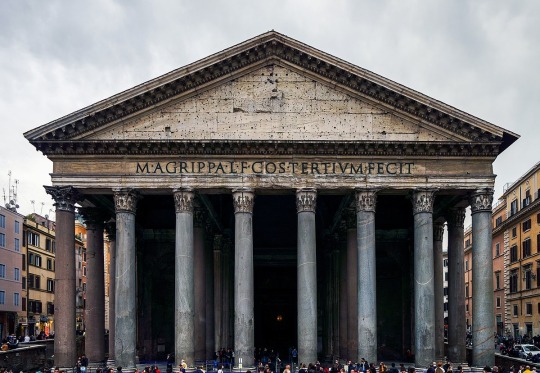
And Agrippa’s Pantheon

Is crammed inside downtown Rome
It just so interesting to notice.
#San Antonio#and other places too#monuments#history doesn't go away#it's still right here under your feet
78K notes
·
View notes
Text
vgb communist: kl komunnisted xcfghvb:// kl vietnam neighborhoods:// bn hj states lay gh states laid on paid candace marie hughes owner:/// bn h: k::/ hhh g:/ fcv x:::/ candace marie hughes owner: papers list d:/ n jhg google.com www.google.com paid warehouses and ware houses lay on paid vietnam country:// b j: k::: paid loked:/ kl o' hnb j/ gv: cf online and on line ownership: containers: listed listed homes:// vg houses cordova, bartlett, memphis tennessee paid seen: see::/ jk loked:/ lok hnj roosevelt as president:// jn vice president fg kow: paid paid lok loked: responsiblity::/ nm k:/// < > / > : on paid candace marie hughes: governor of saigon in vietnam country paid loked:// bn j. lok loking lokings: loked:: op90-8 hjbn g 15 dcf houses paid lay freedom.
0 notes
Text
How to Plan a Spectacular Event in Los Angeles: Expert Tips for a Flawless Experience
Los Angeles is a city known for its glamour, creativity, and high-energy events. Whether you’re organizing a corporate function, product launch, luxury wedding, or brand activation, planning a successful event in this vibrant city requires careful strategy and attention to detail. Event Planning Los Angeles is more than just securing a venue and sending invitations—it’s about crafting unforgettable experiences that captivate attendees.
From selecting the perfect venue to incorporating cutting-edge technology, this guide will walk you through essential steps for seamless event management in Los Angeles while ensuring your guests leave with lasting memories.
1. Define Your Event Goals and Vision
Before diving into logistics, you must establish a clear vision for your event. Ask yourself:
What is the purpose of the event? (e.g., corporate networking, product launch, brand awareness, or personal celebration)
Who is your target audience? (VIP clients, employees, influencers, or the general public)
What key message or experience do you want guests to take away?
Having a well-defined goal will shape the theme, branding, and overall experience, ensuring consistency across every touchpoint. Whether you're organizing a gala dinner or a high-energy experiential marketing event, your vision will guide the planning process.
2. Select the Perfect Venue
Los Angeles offers a wide range of venue options, from rooftop gardens with skyline views to historic theaters and beachfront resorts. Your venue plays a critical role in setting the tone for your event.
Considerations When Choosing a Venue:
Location: Ensure the venue is easily accessible and convenient for attendees.
Capacity: Choose a space that comfortably accommodates your guest list.
Aesthetic & Ambiance: The venue should align with your event’s theme and branding.
Amenities & Services: Check for built-in AV equipment, lighting, parking, and catering options.
Popular LA venues for event planning in Los Angeles include The Beverly Hilton, The Hollywood Roosevelt, and unique warehouse spaces in the Arts District.
3. Focus on Experiential Event Design
In today’s competitive event industry, simply hosting a gathering isn’t enough. Experiential events in Los Angeles focus on creating immersive, interactive moments that emotionally connect with attendees.
How to Elevate Your Event with Experiential Elements:
Immersive Technology: Incorporate virtual reality (VR) and augmented reality (AR) for interactive brand storytelling.
Live Entertainment: Surprise guests with live performances, DJs, or acrobatic acts.
Themed Installations: Design creative photo backdrops and interactive booths that encourage social media sharing.
Gamification: Engage attendees with digital scavenger hunts, quizzes, or giveaways.
Whether it's a corporate launch or a private celebration, experiential elements add an extra layer of excitement and engagement.
4. Create a Seamless Event Timeline
Efficient event management in Los Angeles requires a well-structured timeline to keep everything running smoothly. Break your event plan into three phases:
Pre-Event Planning: (3-6 Months in Advance)
Define budget and goals.
Secure the venue and vendors.
Develop a marketing strategy and guest list.
Design invitations and promotional materials.
Event Execution: (On the Day of the Event)
Set up venue, décor, and AV equipment.
Coordinate with vendors and staff.
Ensure seamless guest registration and check-in.
Monitor the schedule and adapt as needed.
Post-Event Wrap-Up:
Gather feedback from attendees and stakeholders.
Share event highlights on social media.
Conduct a debrief with your team for future improvements.
Send thank-you emails or gifts to guests and sponsors.
A well-organized event timeline ensures that no detail is overlooked, resulting in a stress-free experience for both planners and attendees.
5. Leverage Technology for Efficient Event Management
Incorporating technology into your event management Los Angeles strategy streamlines processes and enhances guest engagement.
Essential Event Tech Solutions:
Event Apps: Use mobile apps to provide schedules, speaker bios, and networking opportunities.
Live Streaming: Extend your event’s reach by streaming sessions for virtual attendees.
RFID & QR Codes: Speed up check-ins and enable seamless cashless transactions.
AI-Powered Chatbots: Provide real-time assistance for guest inquiries.
Using digital tools not only improves efficiency but also enhances the overall guest experience.
6. Catering: The Key to Guest Satisfaction
Food and beverage choices can make or break an event. Offering a diverse menu that caters to different dietary needs ensures all guests feel included.
Trendy Catering Options in Los Angeles:
Interactive Food Stations: Sushi rolling, DIY taco bars, and nitrogen ice cream stands add an entertaining twist.
Plant-Based Menus: Vegan and sustainable dining options are increasingly popular.
Craft Cocktails & Mocktails: Signature drinks tailored to your event’s theme make a lasting impression.
Hiring a top-tier catering company ensures that presentation, taste, and service align with your event’s overall vision.
7. Maximize Social Media and Branding Opportunities
For corporate and brand-focused events, a strong digital presence is essential. Social media helps amplify your event’s reach, both before and after the occasion.
Social Media Strategies for Events:
Pre-Event Hype: Tease highlights on Instagram, LinkedIn, and Twitter.
Event Hashtags: Create a unique hashtag for attendees to use when sharing photos.
Live Updates: Engage remote audiences by posting real-time updates and behind-the-scenes content.
Influencer Partnerships: Invite influencers to share their experiences and promote your brand.
Branded photo booths, LED screens, and interactive walls also reinforce your event’s identity and encourage organic marketing.
8. Work with a Professional Event Planning Team
Planning a flawless event in a city as dynamic as Los Angeles requires expertise. Partnering with an experienced event planning Los Angeles company ensures a stress-free process and outstanding results.
Why Hire Professional Event Planners?
Access to exclusive venues and trusted vendors.
Expertise in managing budgets and logistics.
Ability to handle unexpected challenges with ease.
Creative insights for unique and innovative event experiences.
Companies like Elite Productions Intl specialize in experiential events in Los Angeles, offering tailored solutions to create immersive and impactful gatherings.
Conclusion
Los Angeles is a city where expectations are high, and event experiences must be exceptional. By defining clear objectives, selecting the perfect venue, incorporating experiential elements, leveraging technology, and working with a professional event management Los Angeles team, you can create an event that leaves a lasting impact.
Whether you’re hosting a corporate gala, a private celebration, or a large-scale product launch, the key to success lies in meticulous planning, innovation, and guest engagement. When executed correctly, your event will not only impress attendees but also strengthen your brand’s reputation and visibility.
For expert event planning solutions, check out Elite Productions Intl—your trusted partner in crafting extraordinary event experiences in Los Angeles.
0 notes
Text
Fan Chon Hoo in New York, #Day 23
This morning I helped out with the winterising event organised by the Gowanus Canal Conservancy. I met Dan Fethke before going to the lowlands nursery. Dan is a filmmaker and producer. He was explaining the Gowanus Canal area to me, and it reminded me of the industrial canal near Hackney Wick in London, which is dotted with workshops, warehouses, and artists' studios. It’s a charming area. GCC is a nonprofit organisation that focuses on environmental advocacy. This morning’s aim was to winterise the plants, which is to prepare the plants to better endure winter. We moved the plants off the pallets, grouped them by species, and created a layer of insulation by building mulch walls around them. It gets cold working outdoors, and one way to keep warm is by generating heat through moving and working. It was a really satisfying and productive day. I could see the Statue of Liberty from a distance as I hopped on the F train at the elevated Smith–Ninth Streets station.

Today is my last session with Nancy. It just dawned on me how quickly time flew past. I thought of the Toastmaster event last week and the expectation for most of us to be articulate, effective speakers; there should be programs to learn how to be better listeners too. And Nancy is a great listener and I’m grateful to have these sessions with her. Her attentive listening helped me to reflect on my time in NYC and learn about myself better.
Later in the afternoon I went to “The Librarian of Rikers,” a discussion with Dominican-American cartoonist Medar De la Cruz and the curator for history at Columbia University's archive, Thai Jones. The event took place at Casa Hispanica, Columbia University. Rikers Island is a prison island in the East River in the Bronx, like Roosevelt Island in the past, except that it is 413 acres, currently the largest jail in New York City and one of the world's largest correctional institutions. Medar’s illustrations of his experience working as a library assistant providing book cart services at Rikers Island won him the Pulitzer Prize this year. He worked at the Rikers Prison during the pandemic; he was focusing on getting books into people’s hands in a system that was severely understaffed. He also said that Rikers is one of the most Dominican places he’s ever been in; he’s never been around so many Dominican Americans in his life. Since he couldn’t use a camera, he had to rely on his memory to capture these experiences, and making cartoons was a way for him to process the world, especially the harsh reality and the mistreatments that are happening within the correctional institution.
The last activity of the day was to tune in to a Zoom session on “Introduction to Artificial Intelligence (AI).”. The main speaker, Tiffany, introduced herself as a solutionist. I believe this introductory class catered to aspiring entrepreneurs or freelancers, as she consistently referred to everyone as "solopreneurs." Throughout the session, my Siri was activated several times whenever she mentioned the word "Siri." She was professing her love for ChatGPT by saying how awesome this technology is, and ChatGPT is her best friend. Then she went on to demonstrate how to get ChatGPT to make meal plans with dietary restrictions, design a syllabus for 5th graders, plan a marketing campaign, and create a skincare routine. Occasionally, a woman, who I believe works with Tiffany, would interject, emphasizing the importance of the use of AI tools to build a thriving business that our future generation can inherit. She also mentioned that she holds a PhD in business administration and that the coaching class, which provides in-depth tutorials on AI tools, costs only $499.
I didn't learn anything new about AI, but I did learn that there are people out there who manipulate the anxiety of those who are new to this technology, encouraging them to unquestioningly embrace it or risk missing or losing out. I felt like I sat in on a live telemarketing program through a Zoom meeting.

tiffanygconsulting.com, mytechacademy.net
*It's likely that AI was used to create these sites.
0 notes
Video
Lead Me to Some Fire by Thomas Hawk
#Corktown#DPS Book Depository#Detroit#Detroit Book Depository#Michigan#Roosevelt Warehouse#Wayne County#abandoned#book depository#fav10#fav25#fav50#flickr
1 note
·
View note
Text
Solar farms versus burrowing owls (LA Times)

Excerpt from an article written by Sammy Roth, climate reporter for the LA Times:
If you don’t love burrowing owls, you’ve probably never seen a burrowing owl.
They’re 7 to 10 inches tall, with bright yellow eyes and long, skinny legs. The western variety doesn’t even dig its own underground burrows. It depends on other critters, such as ground squirrels and desert tortoises.
Building solar projects in spots where burrowing owls are struggling to survive would be a terrible idea, right?
I’ve said it before, I’ll say it again: If only the world were so simple.
As my L.A. Times colleague Lila Seidman reports, the California Fish and Game Commission voted unanimously last week to make the bird a candidate for protection under the state’s Endangered Species Act. In practice, that means burrowing owls will be protected under the law for the next 12 to 18 months, while state wildlife officials study whether the adorable bird deserves permanent status as a “threatened” or “endangered” species.
Two decades ago, there were as many as 10,500 breeding pairs of burrowing owls in the Golden State, according to the California Department of Fish and Wildlife. Now there are just 6,500 pairs, the department estimates.
Suburban sprawl was the biggest culprit, conservation groups say, with residential and commercial development tearing up owl habitat across the state and giving the funky little birds precious little space to nest and breed.
But other industries contributed to habitat fragmentation and destruction too — including renewable energy.
Not many wind farms are being built in California these days, at least on the shore; the windiest spots have long been taken. But lots of massive solar farms are being planned and built to replace planet-wrecking fossil fuels.
Conservation activists want state officials to impose new requirements on energy companies looking to build in burrowing owl habitat — requiring them to pay for the permanent protection of breeding grounds, for instance. Activists also hope state officials will block construction of solar projects in the best spots for burrowing owls.
“We can have abundant burrowing owls and abundant solar development,” said Jeff Miller, a senior conservation advocate at the Center for Biological Diversity. “I don’t think the [protections] will slow solar development.”
I hope he’s right. But I’m a little anxious.
It’s not just burrowing owl advocates who are concerned about the the consequences of solar sprawl. It’s desert tortoise advocates and Joshua tree advocates. It’s rural residents who don’t want solar in the backyards, and farmers who don’t want solar projects taking away cropland — even when they don’t have enough water for all their crops.
If only we could put all the solar panels we need to replace fossil fuels on rooftops, warehouses and parking lots, this problem would be easy to solve. Alas, even optimistic researchers say we wouldn’t come anywhere close.
There are also valuable opportunities to build solar in “low-harm” spots — abandoned farmlands, former mines, contaminated Superfund sites, oil and gas fields, landfills, even strips of land along highways. A report released this month by the Roosevelt Institute and the Climate and Community Institute estimated that the United States has nearly 226 million acres of such land — an order of magnitude more land than we’ll ever need for solar.
Again, if only the world were so simple.
Conservationists have been touting low-conflict solar sites for a long time; there have been optimistic reports like this one before. Yet so far, there have been only a handful of projects built in truly low-conflict spots, such as a set of solar panels over a canal that were switched on this month by Arizona’s Gila River Indian Community.
There are lots of reasons for the dearth of progress. In some cases, the low-harm spots aren’t near electric lines, which are needed to send power to customers; in others, developers aren’t willing to take on the financial liability of building on a toxic Superfund site. Some private landowners aren’t willing to sell — not currently a problem on federal lands, where the Biden administration has made renewable energy development a top priority.
1 note
·
View note
Text
CJ Hendry moves "100,000 plush flowers" installation overnight

Australian artist CJ Hendry was forced to move her Flower Market installation of 100,000 "plush flowers" overnight from a New York City island to a Brooklyn warehouse due to overcrowding. The Flower Market installation took place over a September weekend and was, at first, located on an embankment of the Louis Kahn-designed FDR Four Freedoms State Park memorial on Roosevelt Island.

Artist CJ Hendry created a "Flower Market" installation located on Roosevelt Island in New York CityOpen from 13 to 15 September, the event was shut down by police on the second day due to overcrowding and was moved overnight to a studio in Brooklyn's Industry City. New York-based CJ Hendry apologised for the closure in an Instagram reel posted to her page on 14 September, promising visitors "we're finding a new location, we're building a new exhibit overnight".

Boxes of "flowers" lined a greenhouseThe installation was re-installed in a large, industrial space in Brooklyn's Industry City, where it "ran smoothly" over the course of 15 September, according to the New York Post. "Industry City for Sunday was a great shift because it's this creative hub, and it gave the final day a different vibe – more industrial, more grounded, but still very much alive," Hendry told Dezeen. Flower Market was originally designed for the FDR Four Freedoms State Park memorial, designed in 1974 by architect Louis Kahn and completed in 2012 to honour a 1941 State of the Union Address by Franklin D. Roosevelt.

Toy-like flowers were made of wiring and wrapped in a plush materialThe installation was a partnership between Hendry, Japanese beauty brand Clé de Peau Beauté and the park's organising non-profit Four Freedoms Park Conservancy. "When the architect Louis Kahn designed this memorial, he said, 'The garden is somehow a personal kind of control of nature,'" said Hendry.

The different flowers represented the botanical ingredients of beauty brand Clé de Peau"A lot of my work, and in this exhibition especially, is about manipulating my environments and building a space that takes participants out of their ordinary. I hope Flower Market inspires joy and beauty well after the greenhouse is empty, every time we see flowers – plush or otherwise." The original installation consisted of an industrial greenhouse tent measuring 120 by 40 feet (36 by 12 metres) filled with boxes of "plush flowers" that guests were invited to "meander" through.

Home Pharmacy is an interactive wall hanging infused with essential oils
The "flowers" are made of metal and wiring covered with a soft, plush material and designed to resemble a range of flower species, including rose, lily, and peony. The choice to create the flowers was driven by botanical ingredients used in Clé de Peau Beauté products, while others were informed by the Roosevelt family, such as a tulip to symbolise the family's Dutch heritage.

Different flower species also represented the Roosevelt familyThey were manufactured by the "biggest plush manufacturer in the world" according to the team. Hendry's use of plush material is in line with her overarching work, which often features a "childhood aesthetic".

Visitors could purchase the flowers"She was just struck by the idea of taking these flowers and these delicate and natural elements and being able to increase the longevity and enjoy them for a long time," CJ Hendry studio director Dylon Harbottle told Dezeen. "Mixed with the childhood aesthetic, we came up with plush and that was kind of the beginning of Flower Market."

The installation was shut down by police on its second day. The photo is by Antonio AjamThe project was two or three years in the making, with Hendry eventually landing on a greenhouse concept. "We had a few iterations before we landed on the greenhouse," said Harbottle. "Everything that we were discussing didn't hit that scale marker."

The team moved the installation overnight to the second location in Brooklyn. The photo is by Antonio Ajam"As soon as CJ was like, 'We just have to go big or not do it at all' – that's how Flower Market was really born." In its Industry City location, the boxes of flowers were spread out over the floor of the space, sans greenhouse.

The last day of the installation took place in a Brooklyn studio in Industry City. The photo is by Antonio AjamCJ Hendry is New York-based Australian artist known for her hyper-realistic drawings and "engaging and thought-provoking" exhibitions. Other large-scale installations in recent weeks include a giant inflatable astronaut for the MTV VMAS 2024 and a four-poster bed to honour Paris' interiors for the city's design week. The photography is by CJ Hendry Studio unless otherwise stated Read the full article
0 notes
Text
Find Liquidation Pallets For Sale In Atlanta
This guide provides comprehensive information on wholesale liquidation, including where to buy liquidation pallets in Atlanta and how to effectively purchase and sell them. We will explore the benefits of buying liquidation pallets and offer guidance on purchasing and recognizing high-demand products within these pallets. The aim of this guide is to assist a wide range of buyers, from small business owners to individual consumers seeking to save money on everyday items, in making informed decisions when purchasing wholesale liquidation products. Key Takeaways: - The Bin Store is the go-to place for buying liquidation pallets in Atlanta, providing access to top locations and recommended sellers. - It is important to understand the categories of liquidation pallets and popular products to maximize profit potential. - Consider factors such as quality and demand when choosing liquidation pallets, and look out for hidden gems in Atlanta-specific truckload liquidation. Understanding Wholesale Liquidation and its Benefits Businesses can take advantage of wholesale liquidation to acquire bulk products at a fraction of their original price, offering a cost-effective solution for purchasing essential and fast-moving goods. This process involves obtaining goods in large quantities from manufacturers, retailers, or distributors looking to sell their surplus inventory. Bulk goods like electronics, clothing, furniture, and more can be procured through liquidation auctions, online liquidation marketplaces, or directly from wholesalers. By leveraging wholesale liquidation, businesses can achieve significant cost savings, leading to increased profit margins, the ability to provide competitive pricing to customers, and faster inventory turnover to align with consumer demand trends. Finding Liquidation Pallets in Atlanta In Atlanta, there are several reputable sellers and warehouse locations where one can find liquidation pallets. These include Half Off Wholesale LLC and Marietta Closeouts on Sandy Plains, as well as various options along Canton Road. Other notable locations in the area for finding liquidation pallets in Atlanta include Discount Deals Liquidation in Decatur on Candler Road, Liquidation Direct in Norcross off Jimmy Carter Boulevard, and Liquidation Warehouse in Fayetteville on Joel Cowan Parkway. Buyers looking for a diverse selection of discounted merchandise can explore offerings at Big Box Liquidation in College Park near Roosevelt Highway or Liquidation Station in Alpharetta on Atlanta Highway. These and other similar businesses offer different types of liquidation pallets, including electronics, clothing, household items, and more. Top Locations for Liquidation Pallets in Atlanta In Atlanta, the top locations for sourcing liquidation pallets include the Cumberland location and several Georgia Liquidation centers, such as those in Flowery Branch. The Cumberland location in Atlanta provides a diverse selection of liquidation pallets, ranging from electronics and clothing to home goods, catering to buyers seeking variety. On the other hand, the Georgia Liquidation centers in Flowery Branch specialize in bulk lots of furniture, appliances, and tools, appealing to businesses in need of purchasing goods in large quantities. Both locations offer competitive prices and opportunities for buyers to acquire pallets at discounted rates. Conveniently situated near major highways and shipping facilities, these locations are optimal for individuals aiming to streamline their purchasing process and maximize profits. Recommended Liquidation Pallet Sellers in Atlanta The top liquidation pallet sellers in Atlanta are distinguished by their VIP services and inventory sourced from leading U.S. department stores like Orotex. Their commitment to quality is evident in the carefully curated premium pallets, guaranteeing that customers receive products in excellent condition. Setting themselves apart, they provide detailed product descriptions and personalized assistance to assist buyers in making informed decisions. Additionally, these top sellers offer fast and efficient shipping options, along with responsive communication channels. Types of Liquidation Pallets Available Liquidation pallets come in various types and categories, such as general merchandise, cosmetics, furniture, and home decoration, offering a diverse range of products suitable for different businesses. General merchandise pallets, containing electronics, apparel, and gadgets, are ideal for retail stores selling consumer goods. Cosmetics pallets, comprising skincare products, makeup, and beauty tools, cater to beauty salons or online beauty stores. Furniture pallets, which may include sofas, tables, and home decor items, provide affordable inventory options for furniture stores. Home decoration pallets, featuring wall art, rugs, and decorative accents, are beneficial for interior designers and home decor stores. Categories of Liquidation Pallets Liquidation pallets consist of various categories of items for buyers, including power tools, mowers, lighting, flooring, and household goods. Power tools within these pallets encompass a wide variety such as saws, drills, sanders, and more, catering to both manual laborers and tradespeople. Mowers in these pallets can range from branded push mowers to riding mowers and even robotic mowers, offering a diverse selection of styles and types. Lighting items may include fixtures, bulbs, and other accessories, while flooring items can encompass tiles, laminates, vinyl, and other materials. Household goods found in these pallets can span from kitchenware to decor, depending on the specific company providing the liquidated goods. Popular Products in Liquidation Pallets High-demand products such as air compressors, appliances, augers, chain saws, and circular saws are among the most sought-after items in liquidation pallets. These products are favored by consumers and retailers alike for their usefulness and the considerable savings they offer. Air compressors cater to both DIY enthusiasts and professionals, while appliances like refrigerators and washing machines meet essential household needs. Recent market trends indicate a growing preference for power tools such as chain saws and circular saws. The popularity of these items in liquidation pallets is attributed to their high quality and the potential for bulk purchasing discounts. Tips for Buying Liquidation Pallets Jeff Manders recommends following expert tips from industry professionals when buying liquidation pallets, which highlight the importance of selecting quality inventory and conducting thorough inspections before making a purchase. One key piece of advice is to establish relationships with reputable liquidation companies to access top-quality pallets. Understanding your market and customer demand enables you to choose pallets containing sought-after items. Engaging with mentors or participating in online communities can offer valuable insights into best practices for purchasing liquidation pallets. Jeff Manders stresses the significance of setting and adhering to a budget when acquiring liquidation pallets. Strategies for Sourcing Quality Liquidation Inventory To source quality liquidation inventory effectively, it is important to implement strategies such as working with reputable wholesalers, conducting thorough inspections, and accessing excess inventory from companies like Orotex North America. Building strong relationships with reputable wholesalers is crucial for establishing reliable sources of quality liquidation merchandise. Regular communication and setting clear criteria for the desired inventory are essential to maintaining a consistent supply of quality goods. Before finalizing any deals, conducting detailed inspections of the liquidation inventory is recommended to uncover any hidden issues that could impact the resale value. Large suppliers like Orotex North America often have surplus amounts of excess, obsolete, and customer-returned inventory available for sale, making them a valuable source of high-quality liquidation merchandise that may not be easily found elsewhere. Leveraging this resource enables businesses to offer a wider variety of competitive inventory to customers. Maximizing Profit Potential with Liquidation Pallets To maximize profit potential with liquidation pallets, strategic pricing, effective reselling methods, and utilizing bulk discounting to reduce costs are key strategies. Setting the right price is crucial for maximizing sales and profit margin, requiring resellers to conduct market research and analyze competitor pricing to determine the optimal price point. Identifying high-margin items within the pallets is essential, focusing on valuable items with high resale potential and demand. Negotiating bulk discounts with suppliers or wholesalers is another effective method to increase profitability, as resellers can secure lower prices per unit, ultimately boosting overall profits. Benefits of Buying Liquidation Pallets The benefits of buying liquidation pallets include cost effectiveness and quick turnover for replenishing stock. Businesses can purchase products at a fraction of their original price, enabling them to maximize profit margins. For instance, buying pallets of customer returns or overstock items can reduce purchasing costs by up to 90% compared to buying individual items at retail prices. Liquidation pallets offer a variety of consumer products, ranging from electronics to clothing to small appliances, which can diversify a business's inventory and attract a broader customer base. This variety helps businesses reach different market segments and adapt to changing consumer demands, ultimately leading to increased sales and revenue. Advantages of Purchasing Liquidation Pallets One of the main advantages of purchasing liquidation pallets is the significant cost savings they offer for rapidly restocking inventory with a wide variety of products. Buying liquidation pallets enables businesses to acquire high-quality items at a fraction of their retail price, thereby boosting profit margins. The assortment of products available on these pallets also enables businesses to broaden their offerings without a substantial investment in new inventory. This adaptability enhances the appeal of businesses to a broader range of customers and helps them stay competitive in a fast-paced market. Improved inventory management is another benefit of purchasing liquidation pallets, as businesses can more effectively regulate stock levels and swiftly respond to consumer demand. This leads to reduced storage expenses and decreased wastage. Guide to Choosing the Right Liquidation Pallets The key criteria for selecting the right liquidation pallets include: - Understanding market demand: This is essential as it helps determine which products are popular and in demand, guiding your purchasing decisions. - Conducting quality checks: This is crucial to minimize the risk of receiving damaged or faulty goods and ensure that the pallets you acquire meet your standards for resale or personal use. - Purchasing from reputable sellers: It is important to select established suppliers with positive feedback and evidence of timely delivery to ensure trustworthy transactions. Factors to Consider When Selecting Liquidation Pallets When choosing which liquidation pallets to buy, key factors to consider include the quality of the merchandise, current market demand, the condition of the items, and the reputation of the seller. Quality plays a significant role in determining the resale value of liquidation pallets. Opting for higher quality goods enhances the chances of attracting a larger buyer pool and securing higher prices. It is essential to inspect the merchandise to ensure they meet quality control standards and are free of damage and defects. Understanding market trends is crucial for making informed purchases. Buyers should stay informed about popular items and emerging niches. Additionally, verifying the credibility of the seller is important. Checking a seller's reviews, ratings, and testimonials from other buyers can help avoid scams and ensure the quality of the merchandise. How to Identify High-Demand Liquidation Products To identify high-demand liquidation products, companies should conduct market research, stay ahead of trends, and prioritize the most profitable items. Market research is most effectively conducted by analyzing consumer behavior and preferences through surveys and feedback. Understanding customer preferences and purchase motivations allows companies to tailor their product offerings accordingly. Monitoring industry trends and competitor activities can also provide insights into emerging opportunities. Once key trends are identified, products can be prioritized based on their demand and potential profitability. This prioritization can be determined by analyzing sales data, profit margins, and projected market growth. Spotting Hidden Gems in Liquidation Pallets Hidden gems in liquidation pallets are valuable products that can be resold at competitive prices. The first step to identifying these valuable items is to research and understand their value before making a purchase. By knowing the product's past market trends and current pricing, you can gauge the potential profit margin. It's also essential to be aware of where certain items can be sold for higher prices, whether it's on popular resale markets online or through local consignment stores. Some common hidden gems found in liquidation pallets include vintage electronics, designer clothing/accessories, collectible toys, rare antiques, and unique collectibles. These items hold a high intrinsic value and are often sought after and purchased by wholesale liquidation buyers. Atlanta-Specific Liquidation Pallets Information Atlanta-specific information on liquidation pallets includes truckload liquidation opportunities, local sellers, and market dynamics unique to the area. Atlanta truckload liquidation offers a diverse range of product categories, such as electronics, clothing, household goods, and furniture. Major sellers in the region often sell these products in bulk, attracting buyers seeking large volumes of goods at discounted prices. Local market trends, such as e-commerce auctions and direct sales, are gaining popularity, facilitating easier participation for businesses and individuals in the liquidation market. The variety of products available through truckload liquidation contributes to Atlanta's strong presence in the liquidation industry. Atlanta GA Truckload Liquidation Overview Truckload liquidation in Atlanta, GA, offers businesses the opportunity to purchase mixed bulk merchandise at a lower price, enabling cost efficiencies and a wide variety of products available in larger quantities. This is advantageous for businesses as it allows them to save on costs and expand their inventory offerings. Truckload liquidation sales can include electronics, clothing, home goods, and more, often at significantly reduced prices. Buying in bulk enables companies to acquire a diverse range of products for a fraction of their original cost. With the potential for high margins, businesses often opt to resell these goods, donate them, or use them for various promotional and marketing activities. Leveraging truckload liquidation opportunities in Atlanta can provide businesses with a strong competitive edge in the current market. Locating Atlanta Merchandise Liquidators To find merchandise liquidators in Atlanta, you can tap into a network of local businesses that specialize in liquidating excess and overstock inventory, offering affordable options for businesses to purchase merchandise. One effective approach is to utilize online resources like business directories or dedicated marketplace platforms tailored to Atlanta. These platforms typically feature listings of liquidation companies, along with ratings and reviews from previous clients, aiding in the decision-making process. Developing connections within the local community can also result in referrals to trustworthy liquidators. Engaging with industry associations or participating in trade shows offers opportunities to connect with local businesses offering liquidation services. Frequently Asked Questions 1. How can I find liquidation pallets for sale in Atlanta? The best way to find liquidation pallets for sale in Atlanta is by searching online or visiting local wholesale stores such as Half Off Wholesale, Auction Liquidators, Wholesale Crazy, Express Liquidators, and Atlanta Wholesale Liquidators. 2. What is the advantage of buying liquidation pallets in Atlanta? Buying liquidation pallets in Atlanta allows you to purchase products at discounted prices, providing you with a cost-effective way to source inventory for your business. 3. Are there any specific stores in Atlanta that specialize in selling liquidation pallets? Yes, there are several stores in Atlanta that specialize in selling liquidation pallets, including Half Off Wholesale, Auction Liquidators, Wholesale Crazy, Express Liquidators, and Atlanta Wholesale Liquidators. 4. How do I contact these stores for purchasing liquidation pallets in Atlanta? Each store has a different contact method, but you can typically find their contact information on their website or by searching online. Half Off Wholesale can be reached at (678) 990-6979, Auction Liquidators does not have a listed contact number, Wholesale Crazy can be reached at (470) 206-0126, Express Liquidators can be reached at (678) 883-4476, and Atlanta Wholesale Liquidators can also be reached at (678) 883-4476. 5. Can I visit these stores in person to purchase liquidation pallets in Atlanta? Yes, you can visit these stores in person to purchase liquidation pallets in Atlanta. However, it is recommended to contact them first to ensure they have the products you are looking for and to schedule a time for your visit. 6. How can I make sure I am getting quality products when purchasing liquidation pallets in Atlanta? It is important to do your research and read reviews before purchasing liquidation pallets from any store in Atlanta. You can also inspect the products in person before making a purchase to ensure their quality. Read the full article
0 notes
Text
youtube
"Spiral":
Masterminds Dispatched:
NSA Admin: Lincoln Chaffey.
"Max".
The molestation of minors as bit for radio pranks, for NEC Comics; the Rhode Island PD's mechanism for refusing officers having matched a print villain, however "The Tick" is the writer's staff, a male pedophile in cause of found to have beaten his wife with physical knuckles of the rear of hand.
UMass-Amherst CI: Scott Peterson.
"Batman Begins".
The attempt at fraud of United States election through MI-6 NSA HUMINT in refusal of potluck, police; the Irish Provisionals, the United States civil services. The found nominal as having promoted an Amish marriage, for transition of ICBM stocks, outside of MI-6 Gentile stock into American Judaism, to betray Britain for Canadian independence in Parliament and an end to the Orange Order of Zulus and their Friendkin.
Air National: John McCain.
"Sons of Anarchy".
The funding to the Church of Satan as an officially registered denomination of domination, mandatory for all Romalians to join, under auspice of leadership of Brian Warner, alias Marilyn Manson, and an end to the refusal of the gay precipice of claim, from that provoked of agency of Romalian.
Homeland Security: Queen Elizabeth II.
"SPECTRE".
The Boston terror bombings, to hide involvement of her grandson, Crown Prince William, prior the office held by Charles III, to prevent amnesty being removed for all Latinos, Africans, or Romalians; the turning of national benevolence, of Saudi Arabia, into ire, at the framing of Chechnyan national allies of Saudi Arabians into a pro-Israeli position unwanted and against Saudi-Jewish identity.
DC Comics: Benjamin Netanyahu.
"Gotham".
The doom of Jews to factory jobs and warehouse labor, at the hands of MENSA, the Mormon faith of found prostitutes having wed and in dismissal of drug and prostitution; unnecessary, already an American police position, however in refusal of African-Americans, essential parts of Washington, Madison, Johnson, Grant, Garfield, and Cleveland, as well as supported by Franklin Delano Roosevelt, as housing for Germans to merge with African lines, to forgive the Holocaust of the Irish.
Army Reserve: Donald J. Trump.
"Fool's Paradise".
The sabotage of American markets to favor the Japanese intelligence services, to pay own daughter, Ivanka, for her police service, at having defaulted on loan to his very own name, due to service in the World Wrestling Federation; Vince McMahon's merger, with the World Wildlife Federation, to produce Atavan; the terrified cat's death, to produce adrenochrome, for management of grocer's unions outside of proper rearing of local town tradition, instead siding with large chains to produce law professors of improper ilk outside own honesty of origin logic. Using film, instead.
NSA HUMINT: Kim Jong-un.
"Assassin's Creed: Syndicate".
A fitting challenge, from an old friend. Webb, would you take Angus, by pale deviled moonlight?
0 notes
Text
Venues & Event Spaces in Austin TX

Title: Exploring the Best Venues and Event Spaces in Austin, TX
Austin, Texas, renowned for its vibrant culture, live music scene, and eclectic culinary experiences, also offers an array of unique venues and event spaces perfect for hosting everything from weddings and corporate gatherings to intimate gatherings and large-scale festivals. Let's take a tour through some of the top venues that encapsulate the spirit of Austin's creative energy and hospitality.
The Allan House: Nestled in the heart of downtown Austin, The Allan House is a historic Victorian mansion dating back to 1883. With its elegant architecture, lush gardens, and vintage charm, it provides an enchanting backdrop for weddings and special events.
The Contemporary Austin – Laguna Gloria: Overlooking Lake Austin, Laguna Gloria is a Mediterranean-style villa surrounded by 14 acres of picturesque grounds and sculpture gardens. This venue seamlessly blends art, nature, and architecture, making it an ideal setting for weddings, galas, and corporate events.
Fair Market: Located in East Austin's vibrant arts district, Fair Market is a versatile event space housed in a former warehouse. Its industrial-chic aesthetic, spacious layout, and state-of-the-art amenities make it a popular choice for concerts, trade shows, and experiential activations.
The Driskill: A landmark of Texas hospitality, The Driskill is a luxurious hotel in downtown Austin known for its grandeur and timeless elegance. With its ornate ballrooms, historic architecture, and impeccable service, it offers an opulent setting for weddings, galas, and corporate functions.
Hotel Van Zandt: Situated in the Rainey Street Historic District, Hotel Van Zandt embodies Austin's laid-back sophistication and musical heritage. Its modern design, rooftop pool deck, and live music venues create a dynamic atmosphere for weddings, parties, and social gatherings.
Brazos Hall: Housed in a historic warehouse dating back to 1909, Brazos Hall combines rustic charm with contemporary amenities. Its open floor plan, exposed brick walls, and soaring ceilings make it a versatile space for weddings, concerts, and corporate events.
Zilker Park: Spanning 350 acres in the heart of Austin, Zilker Park offers a picturesque outdoor setting for festivals, picnics, and recreational activities. With its sprawling lawns, scenic trails, and iconic landmarks like Barton Springs Pool and the Zilker Botanical Garden, it's a beloved destination for locals and visitors alike.
The Roosevelt Room: As one of Austin's premier cocktail bars, The Roosevelt Room offers a sophisticated atmosphere for private events and mixology classes. Its eclectic decor, inventive cocktails, and knowledgeable staff ensure an unforgettable experience for guests.
Native Hostel: Blending contemporary design with bohemian flair, Native Hostel is a hip venue located in East Austin. With its communal spaces, artisanal cuisine, and eclectic programming, it's a popular choice for weddings, art exhibitions, and pop-up events.
Lady Bird Johnson Wildflower Center: Celebrate amidst the beauty of Texas Hill Country at the Lady Bird Johnson Wildflower Center. This botanical garden showcases native plants and landscapes, providing a serene backdrop for weddings, galas, and nature-inspired events.
Whether you're planning an elegant soirée, a lively concert, or a relaxed gathering, Austin offers a diverse array of venues and event spaces to suit every occasion. With its blend of southern hospitality, creative energy, and natural beauty, the capital of Texas continues to inspire and captivate event planners and attendees alike.
#Venues & Event Spaces in Austin TX#Wedding event in Austin TX#Catering Services in Austin TX#Decoration Services in Austin TX#Venues & Event Spaces near me#Wedding event near me#Catering Services near me#Decoration Services near me
1 note
·
View note
Text
"Somewhere in England, Maj. Charity E. Adams,...and Capt. Abbie N. Campbell, ...inspect the first contingent of Negro members of the Women's Army Corps assigned to overseas service." 2/15/1945. NARA ID 16214.
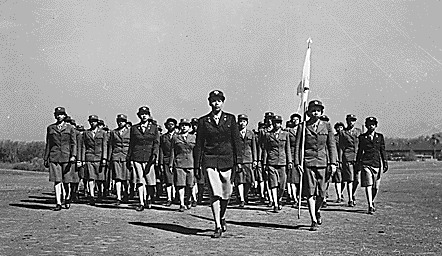
Women’s Auxiliary Corps Captain Adams drills her company 5/1943. NARA ID 531334.
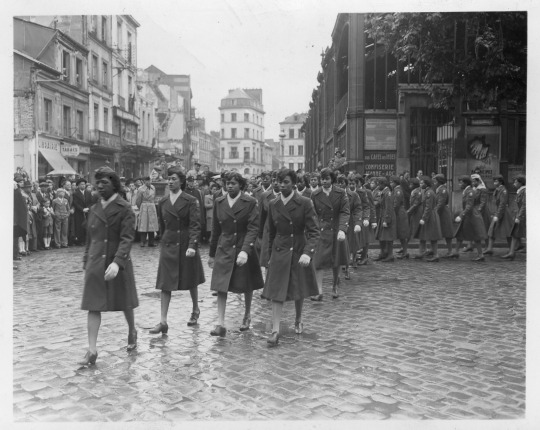
"The negro WAC battalion's first parade on the continent. Rouen, France." 5/27/1945. NARA ID 175539237
Black Female WWII Unit Gets (Congressional) GOLD! WWII's 6888th Central Postal Directory Battalion By Miriam Kleiman, Public Affairs
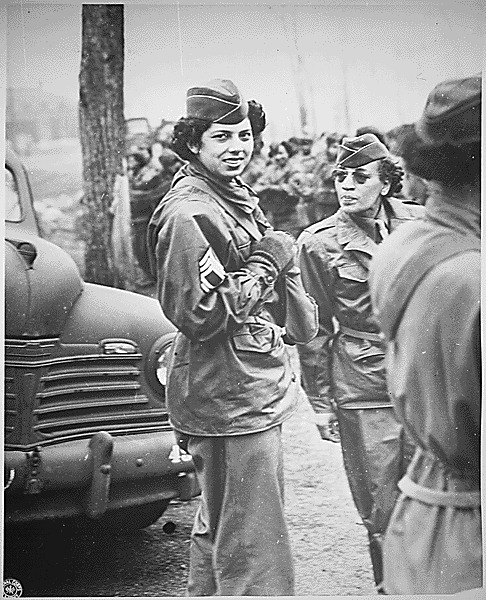
"Tech. Sgt. Tommye Berry, Acting 1st Sgt. of the Negro WAC group" 4/16/1945. NARA ID 535929.
The Women’s Army Corps (WAC) was signed into law by President Roosevelt and set to active duty status on July 1, 1943, but this group did not include Black women. First Lady Eleanor Roosevelt and Civil Rights icon Dr. Mary McLeod Bethune (see: related Tumblr post) advocated for the inclusion of Black women who were eager to contribute to the war effort.
Finally, approval was gained, volunteers enlisted, and the battalion trained at Fort Oglethorpe, GA. In February 1945, the women of the 6888th Central Postal Directory Battalion (the self-proclaimed “Six Triple Eight”) deployed - becoming the only all-Black, all-female unit to serve in Europe in WWII. They were led by Major Charity Adams, the highest-ranking Black woman in the US Army during WWII.
The 6888th organized and sorted mail for delivery to U.S. soldiers in Europe. They worked around the clock, fighting not only the mail backlog but also racism, sexism—and the Third Reich.
On March 14, 2022, President Biden signed a bill into law to award the women of the 6888th Battalion a Congressional Gold Medal "in recognition of their pioneering military service, devotion to duty, and contributions to increase the morale of personnel stationed in the European theater of operations during World War II." Award ceremony date TBA.
The 6888th by the numbers:
855 - # of Black women in the 6888th
3 - # of months it took them to clear a 6-month backlog of mail.
3 separate 8-hour shifts, 7 days a week - work hours.
65,000 - # of pieces of mail processed per shift
17 million - # of pieces of mail processed by the conflict’s end.
77 years - # of years wait for these women to be honored by Congress
The 6888th faced overflowing warehouses stacked with letters and packages for anxiously awaiting GIs. The women of the 6888th knew the importance of such connections to the soldiers and embraced as their motto: “no mail, low morale.” Facing huge volumes of “undeliverable” mail, they developed a tracking system using 7 million servicemember ID cards to correctly route the letters and package.
“The women of ‘Six Triple Eight’ confronted warehouses stacked to the ceiling with letters and packages. These buildings were unheated and dimly lit, the windows blacked out to prevent light showing during nighttime air raids. Rats sought out packages of spoiled cakes and cookies,” the Army said.
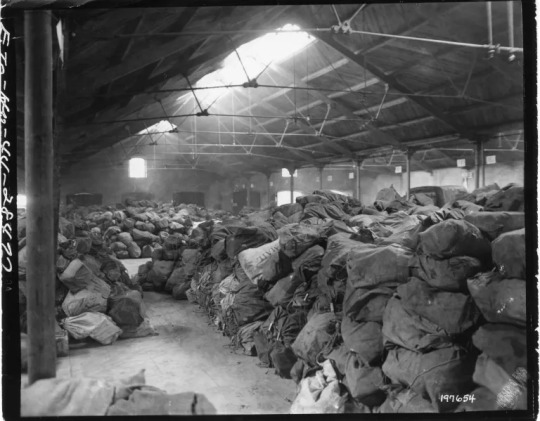
Example of the backlog of vast quantities of Christmas mail en route to American soldiers.” NARA ID 111-SC-197654.
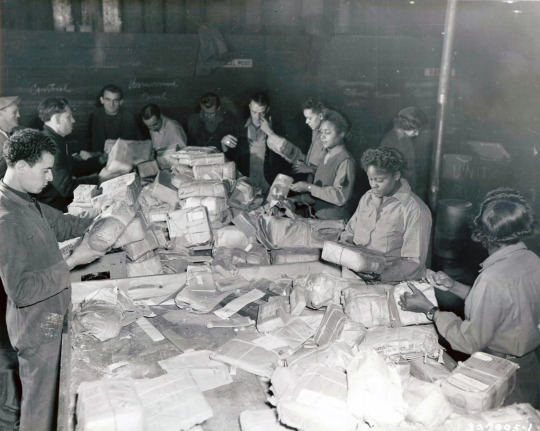
“WACs sort packages, taken from the mail sacks by French civilian employees, at the 17th Base Post Office. Paris, France.” NARA ID 175539203.
Continuing legacy of the 6888th:
The 6888th returned to the United States in February 1946 and was disbanded without any public appreciation or official recognition of their work. However, their accomplishments led the General Board, United States Forces European Theater, to note in their December 1945 study of the Women’s Army Corps: “[T]he national security program is the joint responsibility of all Americans irrespective of color or sex” and “the continued use of colored, along with white, female military personnel is required in such strength as is proportionately appropriate to the relative population distribution between colored and white races.”
11/30/2018: monument in Fort Leavenworth, Kansas was made in their honor.
2/25/2009: The 6888th women were honored Arlington National Cemetery's Women in Military Service for America Memorial.
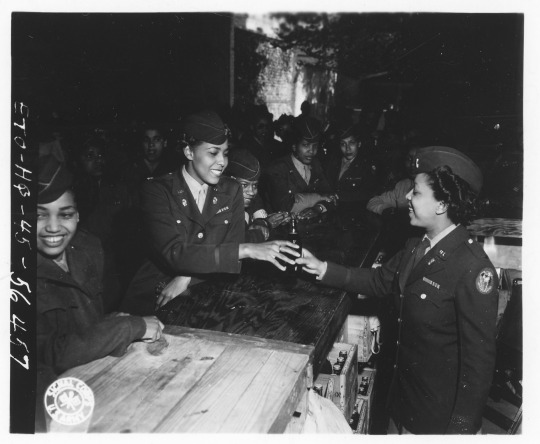
"Post exchange officer serves the first Coca Cola to Major Charity Adams at the grand opening of the WAC battalion's new snack bar. Rouen, France." NARA ID 175539159.
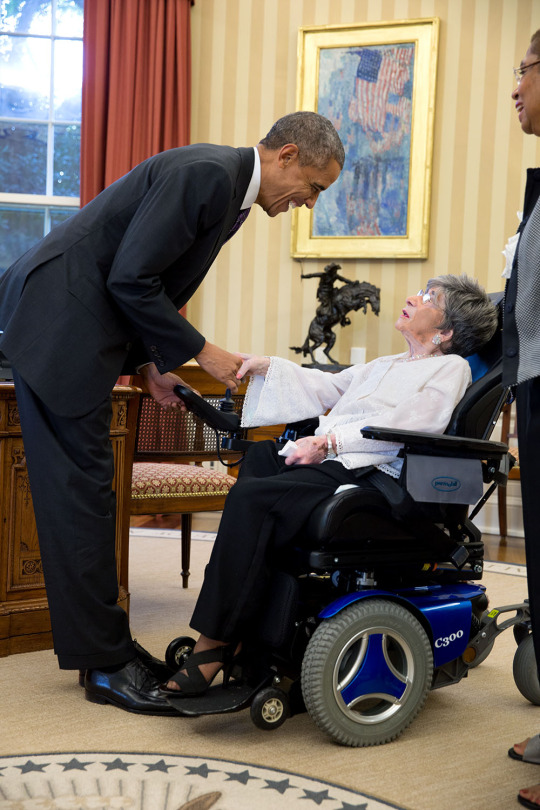
President Obama greets Alyce Dixon, the oldest living Black American WW2 veteran, in the Oval Office, 10/27/2014. NARA ID 176552374.
See also:
Washington Post story on Romay Johnson Davis: She joined the only Black female unit sent overseas in WWII. Now 102, she’s the oldest living member.
No Mail, Low Morale: The 6888th Central Postal Battalion, Unwritten Record
Their War Too: US Women in the Military During WWII, The Text Message
Pictures of African Americans During World War II
African American Women in the Military During WWII, Blog Post
6888th Central Postal Directory Battalion, US Army Center of Military History
The SixTripleEight: No Mail, Low Morale, The National WWII Museum
Women of the 6888th Central Postal Battalion
H.R.1012 – ‘Six Triple Eight’ Congressional Gold Medal Act of 2021, Congress
The 4th in our series celebrating Black History Month (Feb) and Women's History Month (March).
We honor WW2’s #InvisibleWarriors!
Fannie Lou Hamer “Nobody's free until everybody's free."
Mary McLeod Bethune to Return to Capitol Hill
#black history#blm#black lives matter#women's rights#women's history month#blackwomen#blackexcellence#women in the military#world war 2#wwii history#blackwomendidthat
838 notes
·
View notes
